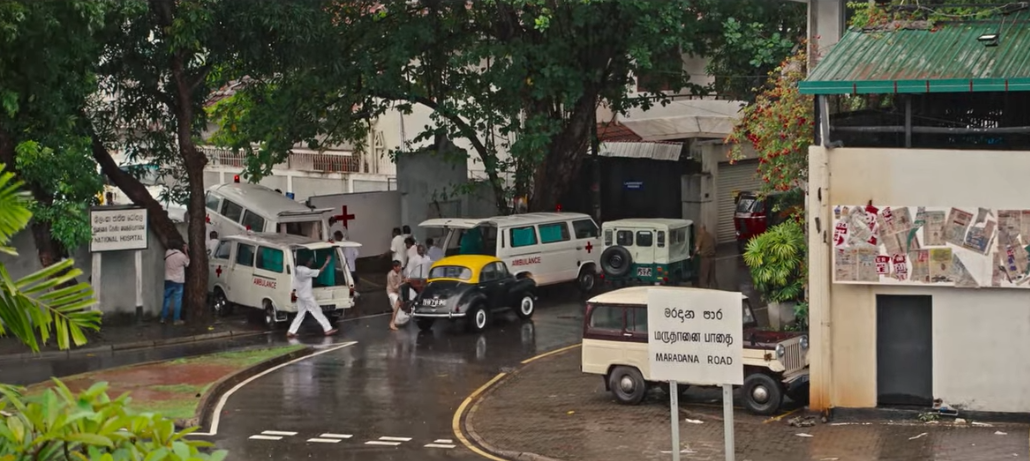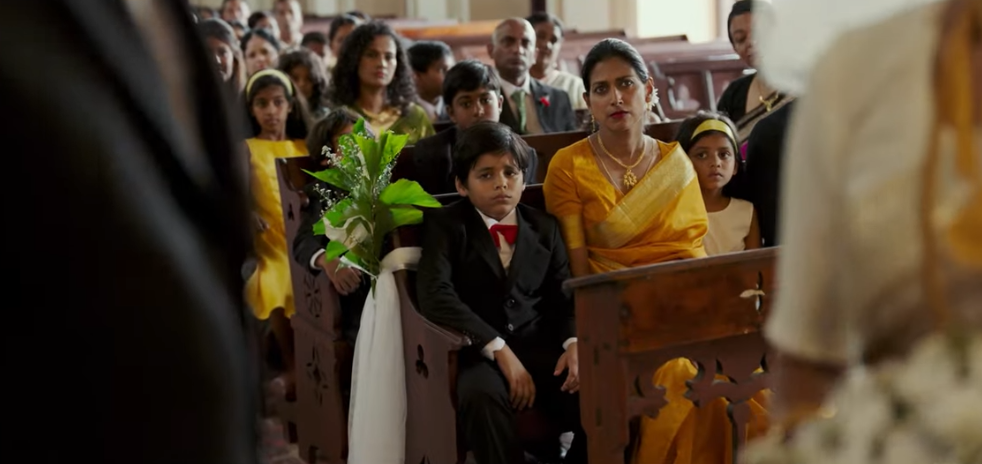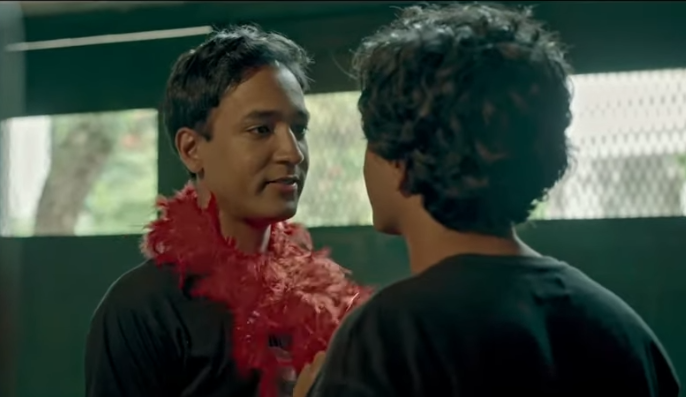“The minute you open your mouth, they will know you are Tamil.”
This line from Deepa Mehta’s Funny Boy is deeply and unintentionally ironic. The film, which was released on Netflix last month and distributed by Ava DuVernay’s ARRAY production company, is based on the novel of the same name by Sri Lankan-Canadian writer Shyam Selvadurai. Chosen as Canada’s official Oscar entry in the category of Best International Feature (and then quickly disqualified for having too much English dialogue), it documents the struggles of growing up queer and Tamil in Sri Lanka. The ever-present irony of Funny Boy is that none of its stars is Tamil—which is evident the minute they open their mouths.
Yet in the early ’80s, when the story takes place, to be visibly and audibly Tamil in Sri Lanka was tantamount to a death sentence. During the ‘Black July’ of 1983, between 400 and 3,000 Tamil civilians were burned, decapitated, killed, raped and shot during anti-Tamil pogroms perpetrated by Sinhalese mobs. Although the riots initially began as a response to a military ambush orchestrated by the Tamil militant group the LTTE (popularly known as the Tamil Tigers), they quickly evolved to feed into a wider mission of ethnic cleansing. The Sinhalese-led government had actively encouraged anti-Tamil sentiments since the 1950s, with policies implementing Sinhala as Sri Lanka’s sole official language and attempts to limit the number of Tamils entering university.
Most adult Tamils from Ilankai (Tamils’ name for Sri Lanka) have a lived history of persecution. In 1983, my mother was living in a girls’ hostel in the capital, Colombo, where the rioting began. I grew up listening to her stories from that time. About the curfews. The terrifying wait for news of her family. The gut-wrenching feeling every time the phone rang, knowing that it could be confirmation of yet another murder. My mother and her family survived 1983, but many others were not so lucky.
 Screenshot: YouTube
Screenshot: YouTubeSelvadurai’s novel is told through the eyes of its young queer Tamil protagonist, Arjun Chelvaratnam or Arjie, played in the film by Brandon Ingram. It was a book that meant a lot to many Tamils, depicting for the first time the complications of being Ilankai Tamil and queer (Selvadurai himself is queer, although, unlike Arjie, he comes from a rare mixed Sri Lankan family; his mother is Sinhalese and his father Tamil). For many queer Tamils, Funny Boy was the first time that they had seen themselves reflected in literature; for the wider Tamil community, it provided a vivid account of the riots that had formed their own history. When she read the novel, my mother said she couldn’t sleep properly for two days, because it reminded her of 1983. For me, it was one of the rare novels that made me cry.
Mehta’s film, however, takes just 109 minutes to erase any representation the book had given us. Not a single member of the main cast is Tamil, save for Arjie’s mother (Nimmi Harasgama), who is half-Tamil, half-Sinhalese. The consequence is a spectacular butchering of the Tamil language, which is perhaps the film’s only consistent feature. Even Harasgama’s performance is surprisingly sub-par. Weird mispronunciations render the dialogue senseless at times—‘his idea’ sounds like ‘her idea’ at one point, and later Harasgama appears to invent a new word, suhanthiram, in place of suthanthiram (‘free’).
The accent of Seema Biswas in the role of Ammachi is the only authentic one in the film, as the original audio recorded by Biswas was entirely replaced by Ilankai Tamil actor Sumathy Balaram.
It’s also disappointing that Mehta chose the light-skinned Agam Darshi, of Indian Punjabi descent, to play Radha, who appears in the book as a dark-skinned Tamil. It would have been a wonderful opportunity for dark-skinned Tamil representation onscreen. I could go on forever about how dark-skinned Tamils are cast aside in favor of light-skinned North Indians, not just in Funny Boy but also in the Indian Tamil film industry, but this is the least of Mehta’s blunders.
 Screenshot: YouTube
Screenshot: YouTubeThe film’s most unforgivable aspect is its casting of ethnically Sinhalese actors to play Tamils in key roles. By placing the oppressor in the literal place of the minority victim, Mehta has engaged in a systematic erasure of the Tamil community. Even in our own stories, it appears, Tamils must be replaced. The absurdity and the outrage of this are multiplied when the actors switch from broken Tamil to fluent Sinhala. It’s as if Han Chinese actors had been cast as Uyghurs in a film about the Uyghur genocide.
This film, with its distribution deal on Netflix, was a chance to raise awareness of Tamil history. But as activists including Sinthujan Varatharajah and Dr Thusiyan Nandakumar have pointed out, the film at times feels like a government-approved narrative of the ethnic conflict in Sri Lanka. Varatharajah has written extensively about Mehta’s problematic links to the government, and Nandakumar describes the film’s attempts to rewrite history by fabricating a Tamil-perpetrated massacre of Sinhalese civilians, and by portraying Sri Lankan police as helpful to Tamils, when in fact police were often complicit in their oppression.
The novel, for example, depicts Arjie’s mother’s lover being killed by the Sri Lankan police. But in Mehta’s film, it is often the Tamil community who causes trouble, with Tamils portrayed as unreasonable nationalists who cannot co-exist with the Sinhalese and demand ‘half of our island’, rather than as marginalized victims in search of a homeland. During the massacre, the ‘bloody Tamils’ are the perpetrators. But when it comes to the riots, there is no explicit mention of who is carrying them out.
At other times, the film feels like an advertisement aimed at refugees seeking asylum in Canada. Whilst the book’s final moments depict Arjie visiting the rubble of his family home, burned down in the riots, the film substitutes tacky scenes in which the family arrives in Canada to be greeted by Radha. Mehta’s version of Radha attends university in Toronto rather than in the U.S., as in the book, and there’s a cringeworthy new scene in which she describes going to Club David’s with her ‘gay pals’. There are no prizes for guessing why Selvadurai and Mehta made these changes to their screenplay, given that the film received funding from the Canadian government through Telefilm Canada, and features the Canadian High Commissioner in a cameo role.

The damage control following the scandal of Funny Boy has been as inept as the film. Producer Ava DuVernay followed and then unfollowed a fake Twitter account supporting the film and claiming to be the “Queer Tamil Collective,” a real group that started a petition to boycott the film. Meanwhile, Mehta hurriedly re-recorded parts of the soundtrack, and later erroneously claimed that 50% of the film’s cast was Tamil.
This last claim is not difficult to debunk. There were fewer than five Tamil actors in speaking roles, and most had just one or two lines. It speaks volumes that the most prominent Ilankai Tamil actors onscreen are those playing the family’s servants, Janaki and Lakshmi (Pathmakumarie Kukapalan and Aksshana Kanageswaran). Maithili Venkataraman, who plays Tanuja (and who is Mehta’s executive assistant), is the only Tamil actor in a named speaking role. She is not an Ilankai Tamil.
Mehta claims she “really tried” to find Tamil actors, but the film’s two casting directors in Sri Lanka are both Sinhalese, and neither appears to have ever worked on a Tamil film. Mehta’s Indian casting directors are Mumbai-based and work exclusively in Hindi. Where are the Tamil casting contacts?
 Screenshot: YouTube
Screenshot: YouTubeThere have been just seven Ilankai Tamil films released in the last 25 years, and Funny Boy was a rare, high-profile chance to add to their number. It could have been so powerful in the hands of Tamil actors, and a Tamil director would almost certainly have tried to convey the novel, and the suffering of the Tamils it depicts, more accurately.
Mehta and Selvadurai’s casting failures reflect a lack of understanding not only of the Tamil community, but of the novel’s broader significance. In an interview with CBC, Selvadurai claimed that Funny Boy is “not a Tamil novel” but rather “a Sri Lankan book,” and refers to Ingram as “a Sri Lankan; one of us”. One has to ask, then: Were all Sri Lankans fleeing their homes during the 1983 riots and hiding in their neighbors’ storeroom while their house was razed to the ground, as Arjie’s family does in the book? The answer is no; they suffered because they were Tamil. It is for this reason that many diaspora Tamils refuse even to identify as Sri Lankan, a fact Selvadurai has been content to gloss over.
Mehta seems to be under this same illusion, claiming, “we were all Southeast [sic] Asian,” justifying both her claim to direct Funny Boy and to cast non-Tamil actors. Her assertion that her casting decisions were valid “as long as I wasn’t getting a white actor” is symbolic of the dangerous cultural and political territory we are wading into worldwide. There is undermining as well as uplift in blurring minority identities in this way.
For a viewer unacquainted with the historical persecution of Ilankai Tamils, the film is an attractive, run-of-the-mill watch, with lush cinematography and easy storytelling, although the lack of political context renders it difficult to follow at times. However, Mehta’s approach grows suffocating by the end, turning intense emotional moments into spoon-fed melodrama; she seems to have unabashedly constructed her film to delight the white gaze, from Radha calling Sri Lanka ‘exotic’ to Shehan educating Arjie on the mythical land of ‘abroad’, ‘where it’s not illegal to be like us’. And indeed Funny Boy has become a critical darling for white critics, many of whom fawned over the rarely seen ‘South Asian gay coming-of-age story’ without taking a minute to re-examine their own neocolonial gaze, and their casual trivialization of oppression.






